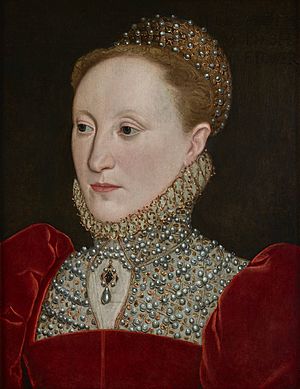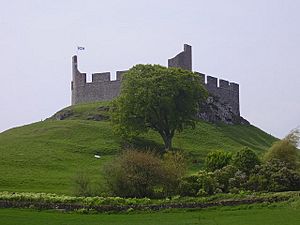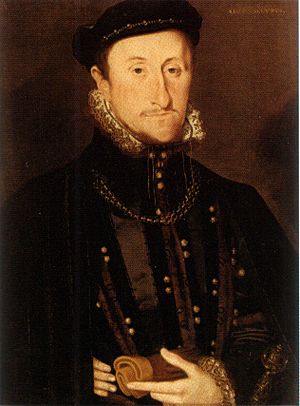John Tamworth facts for kids
John Tamworth (died 1569) was an important person in England during the time of Queen Elizabeth I. He worked for the Queen at her court. He was also a Member of Parliament, which means he helped make laws. Later, he became an ambassador to Scotland.
Contents
John Tamworth's Life and Work
John Tamworth was the son of Thomas Tamworth and Elizabeth Denkaring. His last name was sometimes spelled "Tomworth" or "Thomworth." It seems he spent some time in Italy in the 1550s. He continued to buy books printed in Italy, like a book of words called The Abundance of Words.
In 1562, he married Christina Walsingham. Her brother was Francis Walsingham, who became a very famous spy master for Queen Elizabeth I. John Tamworth was a Member of Parliament for a place called Boston in 1563.
Working for the Queen
Tamworth held two important jobs for Queen Elizabeth I. He was a Groom of the Privy Chamber. This meant he was a trusted servant who helped the Queen directly. He was also the Keeper of the Privy Purse. This job meant he managed the Queen's personal money. A record of her spending still exists today.
Tamworth's records show many interesting things. He received £100 from the city of Coventry when Elizabeth visited in 1566. He also got £100 from Oxford. He bought jewels, precious stones, and pearls for the Queen. He paid for lute strings for music and even bought a large musical instrument called a sackbut for Elizabeth. He also paid for perfumes and bookbinding. The Keeper of the Privy Purse also paid the salaries of the Queen's ladies-in-waiting. Tamworth paid for supplies for the Queen's silkwoman and for gold lace used by her tailor. He also paid workers, including a "Mistress Launder." She was given 520 pearls to remake the Queen's special collars, called partlets.
Managing the Queen's Hunting Gear
Tamworth was also in charge of "Toyles." These were large canvas cloths used to cover wagons. They were also special nets used for hunting. His records mention 75 cloths bought for "the Toyle" in July 1566. Queen Elizabeth hunted at places like Hatfield and Kenilworth. It seems she didn't use this type of hunting very often. However, Queen Mary I and King Philip II of Spain used a "toyle" for hunting in Windsor forest in 1554.
A Mission to Scotland
In 1565, John Tamworth was sent as an ambassador to Scotland. His job was to deal with problems about Mary, Queen of Scots, marrying Lord Darnley. He also dealt with a rebellion called the Chaseabout Raid. Tamworth brought several complaints from Elizabeth. He also advised Mary not to change the Scottish Reformation, which was about the new Protestant church.
He brought money for Agnes Keith, the wife of James, Earl of Moray. Moray was leading the rebellion. Tamworth was told to speak to Mary in favor of Moray, who was Mary's half-brother. Mary did not welcome him warmly on August 7. She told him that Elizabeth should "meddle no further" with her personal matters.
Tamworth refused a travel pass signed by Mary and Darnley. This was because Queen Elizabeth had not yet recognized Darnley as a co-ruler. There were some threats against Tamworth and another English ambassador, Thomas Randolph. On his way back to England, Tamworth was stopped by 30 horsemen. He was held at Hume Castle for five days in August 1565.
Queen Elizabeth I complained to a French diplomat about Tamworth's arrest. Randolph spoke to Mary at Holyrood Palace to get Tamworth released. Mary agreed to send a letter to Lord Home to free him.
Money for the Earl of Moray
After meeting Mary in August 1565, Tamworth talked with Moray and his friends. He thought a rebellion was likely. So, he sent for the money Elizabeth had promised them. Later, two Scottish landowners, James Nicolson and John Johnston, fled to England. They wrote to Elizabeth for help. Mary had sent soldiers to take over their homes. Nicolson and Johnston had delivered the "first aid of money" from Tamworth to Moray.
Mary wrote about John Johnston and the English money in a letter in 1566. She had pardoned Johnston. He told her what happened. Mary wrote that Johnston had delivered 3,000 crowns from Randolph and Tamworth to Agnes Keith, Lady Moray. This showed that Elizabeth was trying to cause trouble for Mary's rule. Mary made Johnston tell the story in front of Randolph. Randolph simply said that Johnston "might speak his pleasure." As a diplomat, Randolph only had to answer to Queen Elizabeth. Mary wanted to send Randolph away. She wanted her ambassador in London to tell Elizabeth about it.
Tamworth's records also mention more money. £3,000 was sent to the Earl of Bedford in September 1565. Another £5,000 was lent to Moray in 1568.
Death
John Tamworth died in Fulham on April 23, 1569. He was buried at St Botolph's Aldersgate. His wife later married William Doddington. Henry Middlemore took over Tamworth's job at court.




